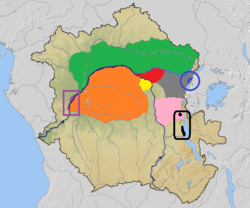Biology:Foa's red colobus
| Foa's red colobus[1][2] | |
|---|---|
| Scientific classification | |
| Domain: | Eukaryota |
| Kingdom: | Animalia |
| Phylum: | Chordata |
| Class: | Mammalia |
| Order: | Primates |
| Suborder: | Haplorhini |
| Infraorder: | Simiiformes |
| Family: | Cercopithecidae |
| Genus: | Piliocolobus |
| Species: | P. foai
|
| Binomial name | |
| Piliocolobus foai (de Pousargues, 1899)
| |

| |
| Foa's red colobus range shown in black | |
Foa's red colobus (Piliocolobus foai) or the Central African red colobus, is a species of red colobus monkey found in the Democratic Republic of the Congo.[1]
Taxonomy
Several other species of red colobus were formerly considered subspecies of Piliocolobus foai by at least some authors but have since been elevated to full species. These include:[4][5][6]
- Lang's red colobus (P. langi)
- Ulindi River red colobus (P. lulindicus)
- Oustalet's red colobus (P. oustaleti)
- Lomami red colobus (P. parmentieri)
- Tana River red colobus (P. rufomitratus)
- Semliki red colobus (P. semlikiensis)
- Ugandan red colobus (P. tephrosceles)
It was previously thought that Foa's red colobus was made of two formerly separate species, one originally from highlands and the other originally from lowlands, which interbred into a single species.[citation needed] The highland species has since been split into P. foai sensu stricto, while the lowland species has been split into P. lulindicus.[7][8]
Distribution
Foa's red colobus is known only from two widely separated regions in the Itombwe Mountains of the Democratic Republic of the Congo. It likely once had a larger range throughout the Albertine Rift in the past, but past deforestation in the area is thought to have led to a major range contraction.[7][8]
Description
Foa's red colobus has long red and black fur on its back and head, with light underparts.[1][7] Males have a body length excluding tail of between 50 and 69 centimetres (20 and 27 in) with a tail that is between 62 and 67 centimetres (24 and 26 in) long.[7] Males typically weigh between 9 and 13 kilograms (20 and 29 lb) and females typically weigh between 7 and 9 kilograms (15 and 20 lb). It has smaller teeth than most other red colobus species.[7]
Behavior
Foa's red colobus is arboreal and diurnal.[1] It has a varied diet which includes leaves, buds, fruit and flowers.[1] It is frequently hunted for bushmeat.[7]
References
- ↑ 1.0 1.1 1.2 1.3 1.4 Saj, Tania, L. (2016). All the World's Primates. Pogonias Press. p. 535. ISBN 9781940496061.
- ↑ "Piliocolobus foai". ITIS. https://www.itis.gov/servlet/SingleRpt/SingleRpt?search_topic=TSN&search_value=944241#null.
- ↑ Hart, J.; Ting, N.; Maisels, F. (2020). "Piliocolobus foai". IUCN Red List of Threatened Species 2020: e.T18252A92659769. https://www.iucnredlist.org/species/18252/92659769. Retrieved 13 November 2021.
- ↑ All the World's Primates. Pogonias Press. 2016. pp. 535–547. ISBN 9781940496061.
- ↑ "Piliocolobus". ASM Mammal Diversity Database. https://mammaldiversity.org/#cGlsaW9jb2xvYnVzJmdsb2JhbF9zZWFyY2g9dHJ1ZSZsb29zZT10cnVl.
- ↑ Oates, John; Ting, Nelson (2015). "Conservation consequences of unstable taxonomies: The case of the red colobus monkeys". in Behie, Allison M.. Taxonomic Tapestries. Australian National University Press. pp. 321–343. ISBN 9781925022360. http://press-files.anu.edu.au/downloads/press/p318011/pdf/15.-Conservation-consequences-of-unstable-taxonomies-The-case-of-the-red-colobus-monkeys.pdf. Retrieved 2019-05-11.
- ↑ 7.0 7.1 7.2 7.3 7.4 7.5 Zinner, D.; Fickenscher, G.H.; Roos, C. (2013). Mittermeier, Russell A.. ed. Handbook of the Mammals of the World: Volume 3, Primates. Lynx. p. 710. ISBN 978-8496553897.
- ↑ 8.0 8.1 Oregon), Nelson Ting (University of; Society), John Hart (Wildlife Conservation; Society), Fiona Maisels (Wildlife Conservation (2020-01-12). "IUCN Red List of Threatened Species: Piliocolobus foai". IUCN Red List of Threatened Species. https://www.iucnredlist.org/en.
Template:C.Colobinae nav Wikidata ☰ Q189980 entry
 |


